-
How To Store Tires and Wheels
Proper tire storage of your seasonal tires and wheels can help them last longer and ensure they’re ready to go when you need them. Whether you have an extra set for winter or summer driving, taking the time to store them properly can protect your investment and make your next seasonal changeover a breeze. In this guide, we’ll cover how to store tires, from winter tire storage to choosing the right location and protecting them from environmental damage.
Store Your Tires with Les Schwab! Select locations can make storing your out-of-season tires and wheels easy until you need them again in the winter or spring. Learn more about this time and space-saving option.

When To Change Your Seasonal Tires
Knowing when to change your seasonal tires is crucial for maintaining optimal performance and extending their life. For winter tires, the best time to switch is when nighttime and early morning temperatures consistently stay at or near 40º F. If you live in a snowy region, switch to snow tires before the first big storm hits.
Please note: using winter tires in warmer conditions won’t ruin them overnight. But they will wear out faster as temperatures rise. Plus, using winter tires in warmer weather can reduce your overall driving performance and increase stopping distances.
For summer tires, the timing is just as important. As temperatures start to climb, summer tires offer better traction and handling when compared to winter tires. Be sure to make the switch as soon as temperatures consistently stay above 45º F.
Steps To Properly Store Your Tires
1. Choose the Right Storage Location
To get the most life out of your winter and summer tires, store them in a cool, dry place. If possible, avoid storing your tires outside in the elements. Repetitive exposure to UV rays can cause the rubber to deteriorate more quickly. While a carport can keep the rain, sunshine, and snow off your seasonal tires, storing them in a garage or shed, away from heaters and furnaces, is preferable. Additionally, keep them covered in a plastic bag.
2. Clean Your Tires Before Storage
Dirt, grime, and debris can build up over time, leading to potential damage. Properly cleaning your tires before storing them can add to their overall lifespan.
Remove Debris: Scrub tires and wheels with soap, water, and a tire brush to remove grime and debris.
Dry Them Completely: Let your tires dry before storage to prevent rust and corrosion on the wheels.
3. Maintain Proper Air Pressure During Storage
If your seasonal tires are mounted to their own wheels, maintaining the correct air pressure is essential to preserve their shape and integrity while in storage. That’s because properly inflated tires are less likely to develop flat spots or deform over time.
For Mounted Tires: Inflate your tires to the manufacturer’s recommended pressure to prevent flat spots.For Unmounted Tires: Store them upright if possible, or stack them no more than four tires high.
4. Bag and Protect Your Tires:
Properly bagging your tires before storage is an essential step in protecting them from environmental factors that can cause damage over time. This process helps maintain the integrity of the rubber and ensures your tires are ready for the next season.

Use Tire Bags:
Once your tires are clean and ready to be stored, store them in plastic bags. If you don’t have tire bags, large industrial garbage bags will also work. The goal is to keep dust, debris, and other harmful elements off your stored tires and wheels.
When you get your seasonal tires changed at Les Schwab, we’ll wrap each of your tires in an easy-to-spot yellow plastic bag. These help protect your tires from UV rays and the weather. They also keep you from getting dirty when you pick them up.
Consider Tire Totes:
As an alternative to standard bags, tire totes can be a nice option for storing and transporting your tires. Tire totes offer a layer of protection against dirt, UV rays, and physical damage.
5. Avoid Chemical Exposure
Maintaining a clean, chemical-free environment is essential for preserving the integrity and longevity of your stored tires. Certain chemicals, particularly ozone created by air purifiers, generators, and furnaces, can cause the rubber to crack and deteriorate over time.
Avoid Ozone Exposure: Keep your tires away from household items that emit ozone, such as generators, compressors, furnaces, switches, sump pumps, and central vacuum cleaners.
Steer Clear of Other Chemicals: Store your tires away from solvents, fuels, and lubricants that can damage the rubber.
6. Store Tires Properly: Stand, Stack, or Hang
At Les Schwab, you’ll notice that we store all of our tires upright. This method takes up less room and can often be better for the tires over a long period. However, aside from buying or building your own tire stand or hanging them from specialized hooks from the ceiling, most people just stack them sideways. Any of these methods will work, and over a handful of months, none will likely cause any damage to your tires. However, don’t stack tires more than four high to avoid injury if they fall. Additionally, if your tires are mounted to wheels, be sure they are properly inflated before stacking.

Benefits of Professional Tire Storage With Les Schwab
Storing your tires with Les Schwab can help free up some space at your home, keep dirty tires out of your vehicle, and make the next seasonal changeover quick and easy. Learn more about this time and space-saving option at select Les Schwab locations.
Keep Your Wheels On
When your winter tires are mounted on wheels (also known as rims), your tires will last longer, your seasonal changeovers will go a lot faster, and it will save you money in changeover fees. Switching yours is free at Les Schwab when you have your tires on their own set of wheels.
Need Help Storing Your Seasonal Tires and Wheels?
The professionals at Les Schwab Tires have been helping people switch to their winter and summer tires for decades. We’re here to help you, too. That includes storage of your seasonal tires.
-
What is Wheel Offset?
Customizing your ride with aftermarket wheels and tires is a fun way to make your car or truck your own. If you’re shopping around, it helps to have a basic understanding of wheel offset.
Proper offset assures your new package has enough clearance so nothing rubs against the suspension, brakes or vehicle body (like fenders, bumpers and mud flaps).
It’s also important for driving safety, since the wrong offset can reduce vehicle stability or interfere with braking.
Wheel Offset and Backspacing Explained
Offset refers to how your car’s or truck’s wheels and tires are mounted and sit in the wheel wells.
- Zero wheel offset is when the hub mounting surface is in line with the centerline of the wheel.
- Positive wheel offset is when the hub mounting surface is in front (more toward the street side) of the centerline of the wheel. Most wheels on front-wheel drive cars and newer rear-drive vehicles have positive offset.
- Negative offset is when the hub mounting surface is behind the wheel centerline. “Deep dish” wheels are typically a negative offset.
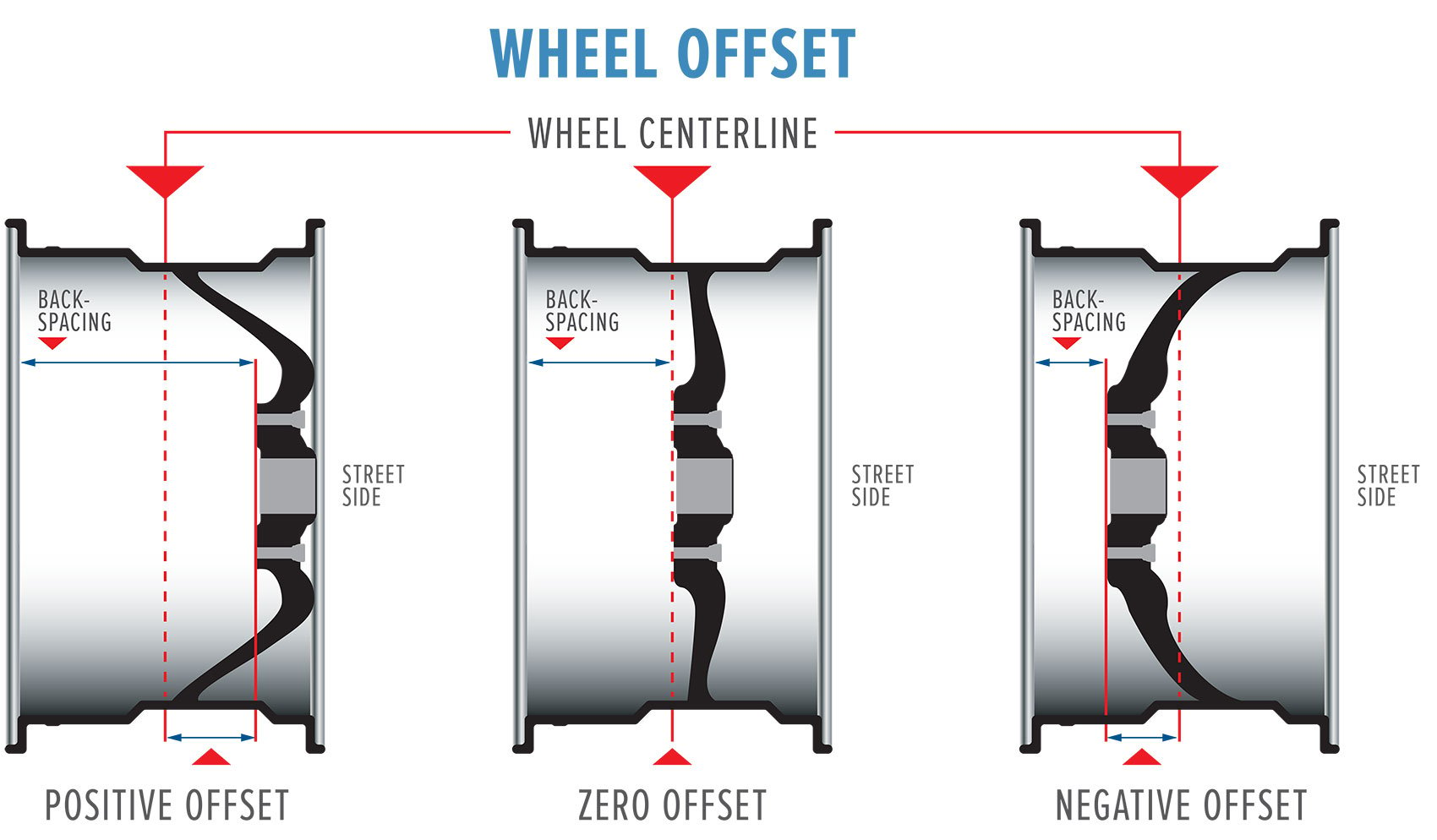
Backspacing is the distance your wheels and tires need to accommodate both offset and wheel width. It’s especially important to factor in when the new package you want is wider than what came on your vehicle.
Getting offset and backspacing measurements right means you’ll get a wheel and tire package that offers the looks, handling and performance you’re after.
Getting them wrong can mean big problems.
Common Problems From Too Much Positive Offset
- Expensive damage from the inner edge of the wheel and tire rubbing against the bodywork or suspension
- Interference with brake parts
- Risk of tire failure
- Poor handling
- Making your car unstable
Problems From Too Much Negative Offset
- Increased steering wheel kick-back
- Additional stress on the entire suspension
- Poor handling
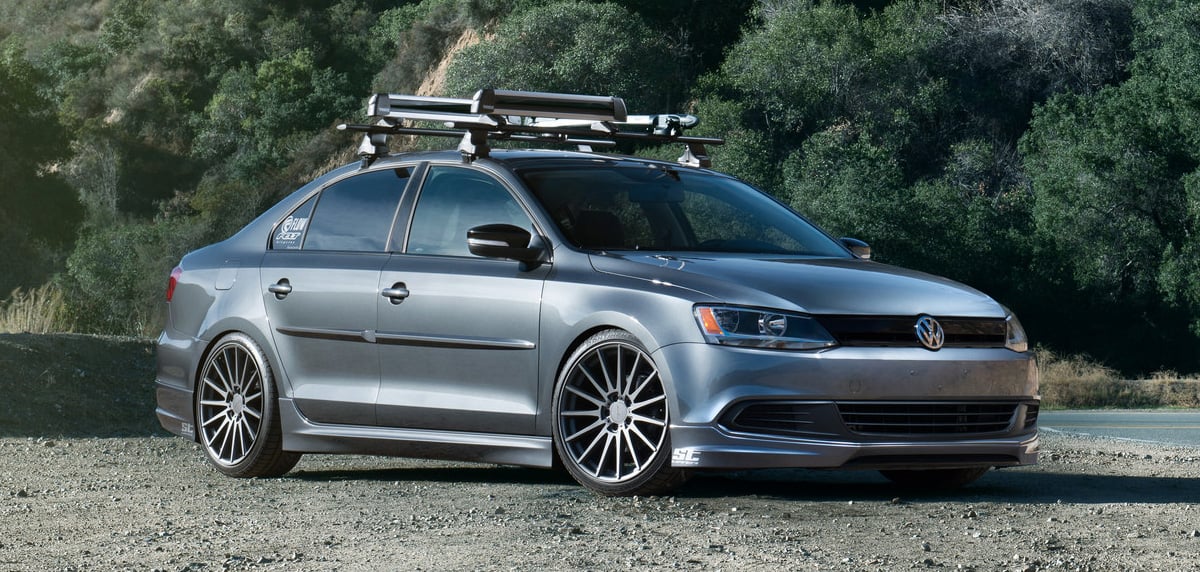
Proper wheel offset example: +43mm offset, wheel size 19" x 8.5", 225/35R19 Toyo Proxes 4 Plus tires
Remember This About Wheel Offset
- New wheels and tires can make your everyday ride look and handle a whole lot better.
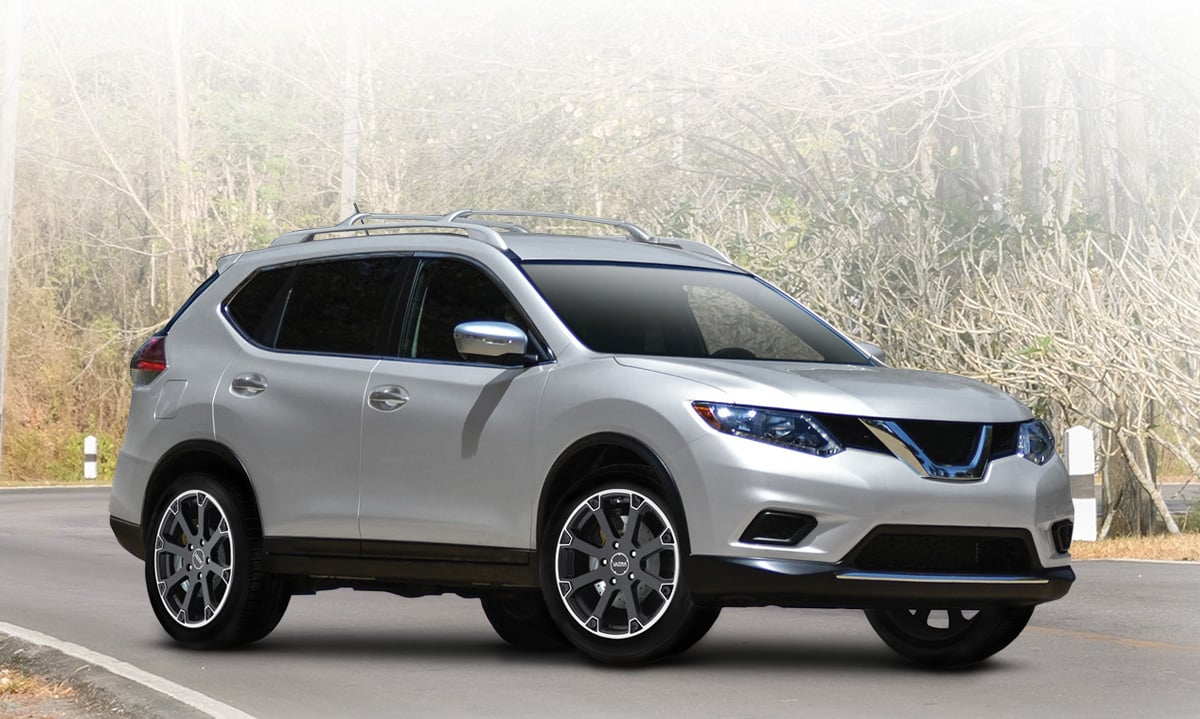
- Offset measurements can be tricky. Even if the tire and wheel have enough clearance, the wrong offset can decrease vehicle stability. Generally, with new wheels, you don’t want the new offset to be more than 5 millimeters different from the old offset.
- Especially when your new wheels are wider than the originals, backspacing has to be factored in along with offset.
- To make sure your tire and wheel package fit right, stay within load capacity and give you the handling and stability you need, ask a tire professional for advice.
Want to see some options that will fit your vehicle? Browse wheels suited for your make and model.
Important Notice: The information provided above is of a general nature gathered from a variety of resources deemed reasonably reliable. The operation of your vehicle, or the repair or replacement of your vehicle’s equipment, may be different than for a typical vehicle. Please consult your owner's manual for specific warnings, notices, and other advice relative to the subjects addressed herein.
Learn More -
What’s the Difference Between Aluminum and Steel Wheels?
Wheels and rims are made with several types of alloys, or blends of metals, with different handling characteristics, maintenance needs and upsides. Here’s a short guide to the two main types of automotive wheel materials and how they differ, for those shopping for aftermarket wheels.
Aluminum Alloy Wheels
Aluminum wheels (sometimes called alloy wheels) are built with a blend of aluminum and nickel. The majority of wheels today are cast aluminum alloy, meaning they’re made by pouring molten aluminum into a mold. They are lightweight but strong, withstand heat well and are generally more attractive than steel wheels. They come in a very wide variety of finishes and sizes. Aluminum wheels are a good choice for a balance of performance, cost, aesthetics, and gas mileage.
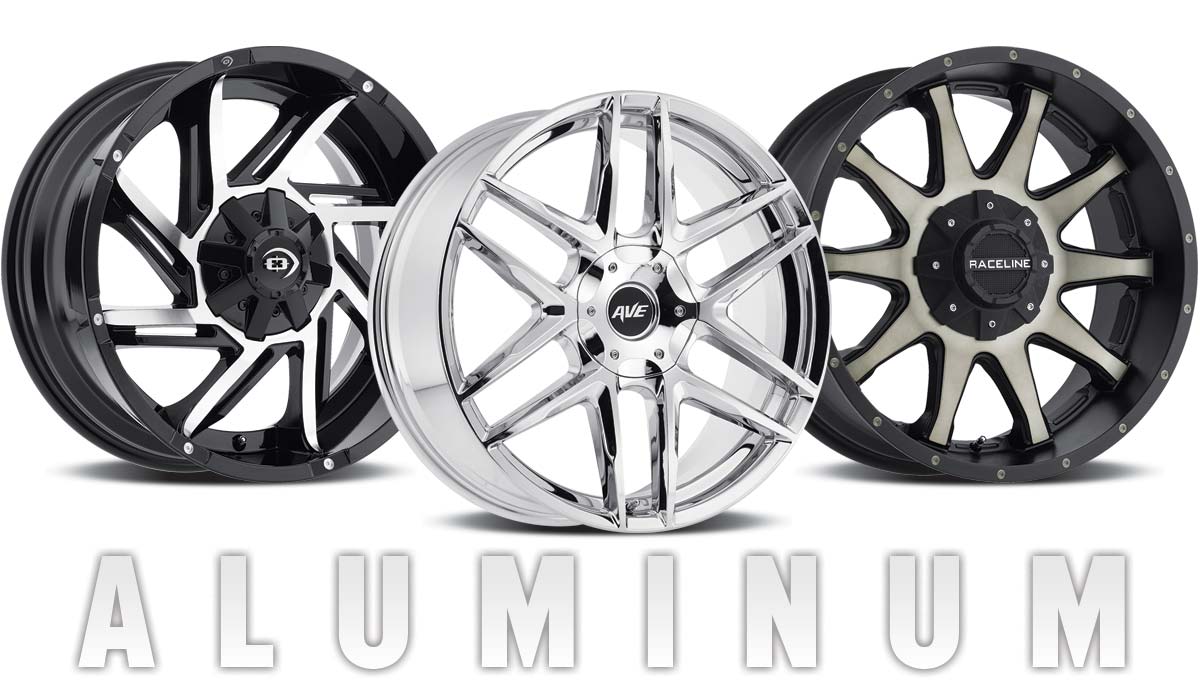
Steel Wheels
Steel wheels are made with an alloy of iron and carbon. They are heavier but they’re more durable and can be easier to repair and refinish. Because of the way they’re made — cut out on a press and welded together — they don’t offer all the aesthetic spoke choices of other wheel types.
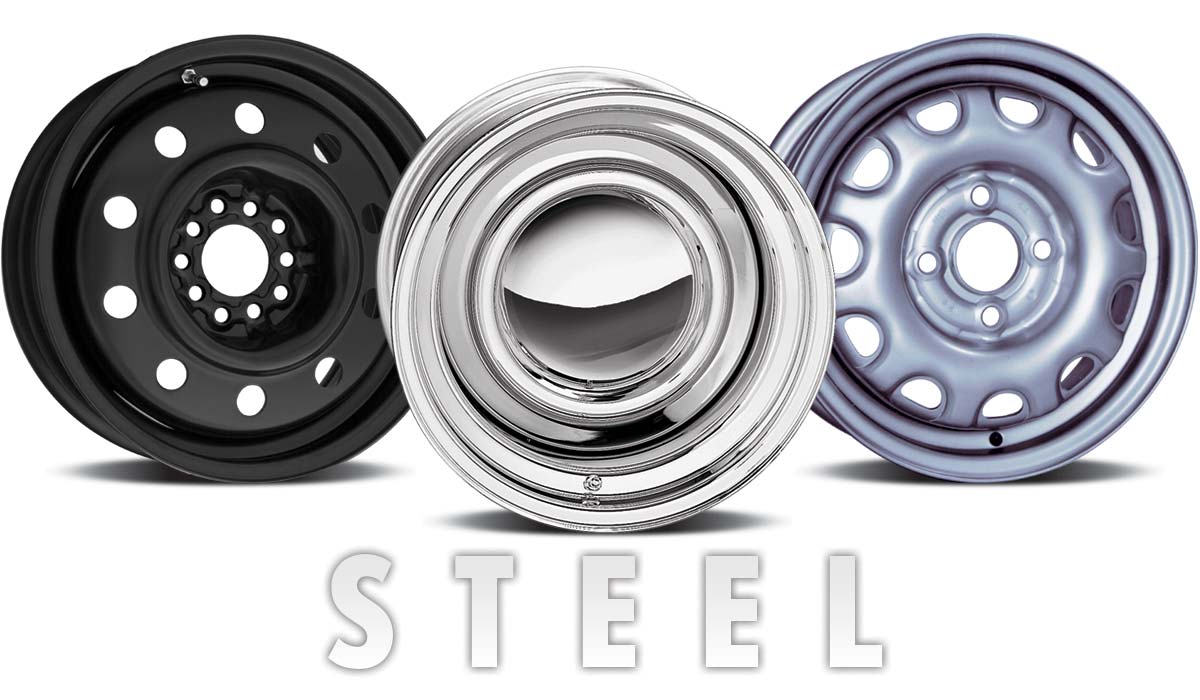
Though their heavier weight may dampen acceleration, agility and fuel efficiency, steel wheels can offer more resistance to impact cracks. They can also be more resistant to damage from deicers, gravel and brake dust, making them more popular for winter driving. Steel wheels are generally less expensive than aluminum wheels.
Here’s a breakdown comparing the characteristics of the two wheel material choices.
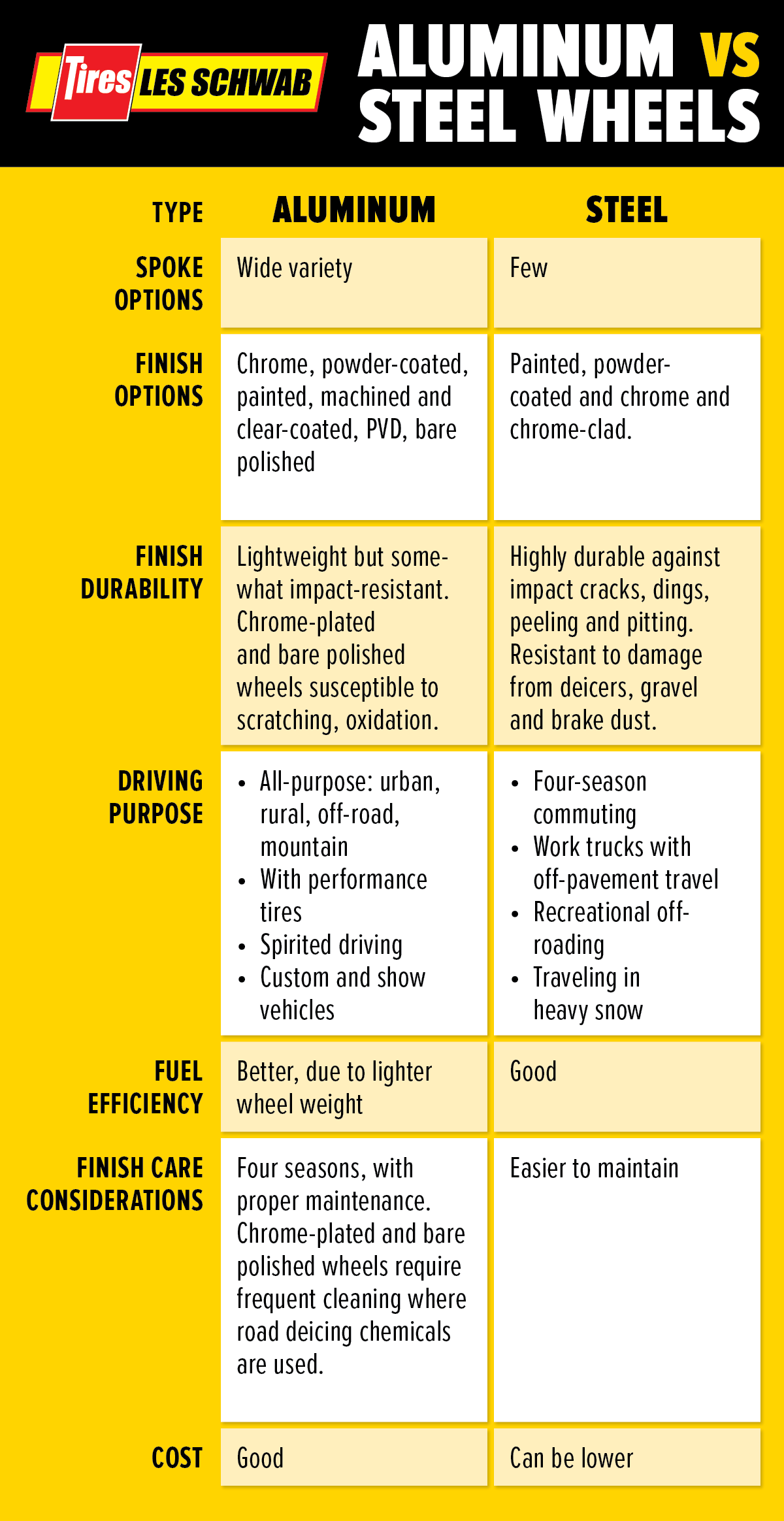
Wheel material is only one factor of many in selecting custom wheels and rims. Learn about wheel finishes and other tips on shopping for wheels in our Learning Center.
Or just stop by any Les Schwab to talk to an expert.
-
A Simple Guide to Wheel Finishes
Custom wheels and rims come in a dizzying number of designs to suit just about any style or performance you’re jonesing for. There are thousands of combinations of metal finishes, spokes, colors, polishes and sizes.
A good start to narrowing down your choices is to understand the types of wheel finishes, how the wheel surface is treated to achieve the color and polish type that suits your style. Each has its own attributes and different degrees of maintenance. Here are the six most common types.

Chrome-plated Finish
This is the classic, mirror-reflective wheel style. Chrome plating has been the traditional method for creating that bling look many drivers want for their ride. Wheels are coated with several layers of copper, nickel and chromium for a highly reflective appearance. This provides the brightest, showiest look of all finishes, nearly as reflective as a mirror.
This finish doesn’t need a protective topcoat to prevent rust. Chrome wheels can also be treated with translucent paints for a variety of color choices.
Care: Chrome wheels require regular cleaning with mild soap and water and soft rags (never an abrasive like steel wool, which will scratch the finish). Maintain the finish with Mothers® Chrome Polish or Instant Detailer. If you are running chrome wheels in wintery locations where deicers like salt and magnesium chloride are used, you should clean them frequently. This will head off finish problems like pitting and corrosion. Clean brake dust off regularly to prevent damage to the finish.
Powder-coated Finish
A dry paint and heat technique is used for a durable, attractive wheel that resists rust, heat, chips and scratches. Fine ground particles of color and resin are electrically charged and sprayed onto the surface. Then the wheel is heated in a curing oven which bakes on the finish.
There are loads of color choices for powder-coated wheels. However, this finish is “one and done.” Recoating in a new color later isn’t recommended.
Care: Use soap and water or a mild, non-acidic wheel cleaner and a microfiber or terry cloth. Never use tarnish or rust removal products or bleach. Clean brake dust off regularly to prevent damage to the finish.
Machined, Clear-coated Finish
Clear coating is used as an additional touch for many wheel finishes. It can be used on raw aluminum wheels or painted wheels.
Some bare metal wheels are machined and then clear coated: A thin layer of metal is shaved off the wheel face for a bright shine, leaving small lines like what you see on a CD. Then the wheel is coated with a clear sealant for protection from corrosion. The clear-coated finish can be appealing for those who like a combination of a machined look with painted accents while providing a protective topcoat. It also assures the wheel paintwork will stay as good as new for years, as long as it’s not nicked or scraped.
Care: Use only mild soap and water or water-based wheel cleaners, not metal polish or any acidic wheel cleaner. Clean brake dust off regularly to prevent damage to the finish. Use Mothers® Foaming Wheel and Tire Cleaner.
PVD Finish
PVD (physical vapor deposition) wheels come with a shine that rivals conventional chrome plating. First, the wheel is coated with primer. Then a very thin metallic coating is applied to the wheel in a vacuum chamber using an advanced electrical bonding method. Last, a clear acrylic powder coating is sprayed on to seal and protect the finish.
There are some benefits to a PVD finish. These wheels are much lighter than chrome-plated wheels, which may get you more nimble driving responsiveness and better fuel economy. They’re available in lots of color tones. The clear coat helps to seal out winter deicing road chemicals, so with proper maintenance, these wheels are a good year-round choice.
And they offer meaningful environmental benefits. The process doesn’t use hexavalent chromium, contains 100 percent of emissions and consumes less energy.
Care: Drive-through car washes, high-pressure washing and chrome cleaners, which contain very harsh acids, could damage the topcoat — and void your wheel warranty. Wash with mild soap and water only and a soft cloth, sponge or microfiber towel. Follow with Mothers® All-Chrome Quick Polish Detailer and Protectant. Clean brake dust off regularly to prevent damage to the finish.
Bare-polished Finish, With or Without Top Coating
Raw aluminum wheels can be hand-polished with a buffer so the surface is completely smooth, then clear coated for a rich shine. Wheels can also be machine-polished to a near-mirror shine with no top coat applied. These are popular finishes for street rod and car enthusiasts who like to show off their ride.
These finishes offer some advantages over chrome-plated wheels since they don’t add weight to the wheel, which could improve fuel efficiency and handling. Polished wheels can also easily be repolished to restore their like-new condition if they lose their luster over time.
Care: If they have no protective top coating, these wheels require regular cleaning, polishing and waxing to keep them from oxidation and pitting. Wash with Mothers® Wheel and Tire Cleaner and polish with Mothers® Polish. Clean brake dust off regularly to prevent damage to the finish.
Painted Finish
Wet paint is used for this finish, followed by a clear topcoat to protect the paintwork. The color tones and polishes available in painted wheels are pretty much endless, from silver tints to matte black to hot pink, or matched to your vehicle’s body paint color.
Care: Use mild soap and water and a microfiber or terry cloth. Follow up with Mothers® Foaming Wheel and Tire Cleaner. Clean brake dust off regularly to prevent damage to the finish.
Wheel Shine Options
Finally, in case these aren’t enough options for you, you can customize the type of shine you like. Wheels can be made with matte (a flatter shine), gloss (high shine), satin (in between matte and gloss) and mirror (reflective) options. You can mix and match these on different parts of the wheel face.
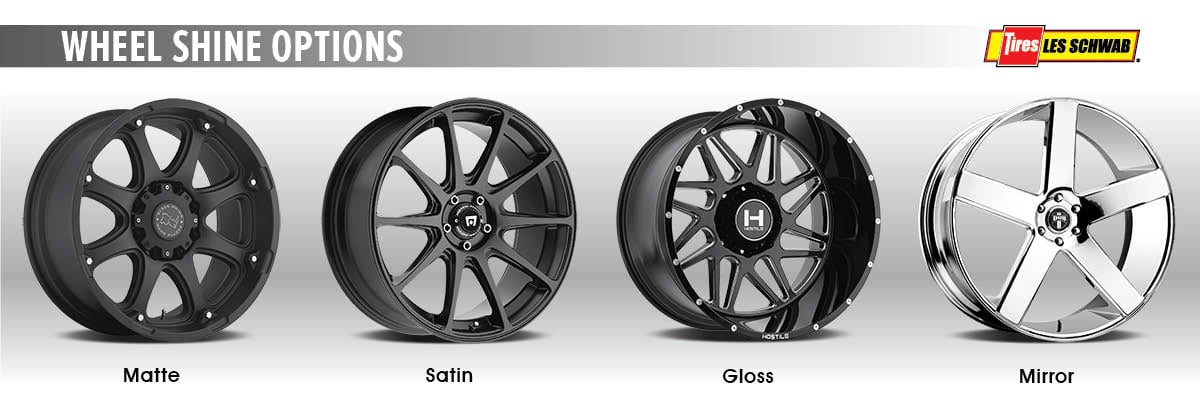
Excited by all these wheel options? Overwhelmed? Learn more about how to shop for custom wheels in our Blog, or just come on in with your questions.
-
How to Choose a New Set of Custom Wheels
Adding a set of custom wheels can add a lot of visual appeal to just about any vehicle. We’ve put together some recommendations to help you choose the right wheels for your car or truck, including aesthetics, safety, size, fit, and tech compatibility.
Looking Good
The style and finish on a set of custom rims can dramatically change the look of your car or truck. Start shopping right now or visit your local Les Schwab where you’ll find Wheel Discovery Centers. There, you can see specific sets of custom wheels on the make, model, year, and color of your vehicle. This is a great way to sift through the many options and narrow your choices before making a commitment.
Think Safety
Proper fit is crucial when choosing custom wheels. The pros at Les Schwab will help you look at three vital areas before choosing your set of wheels.
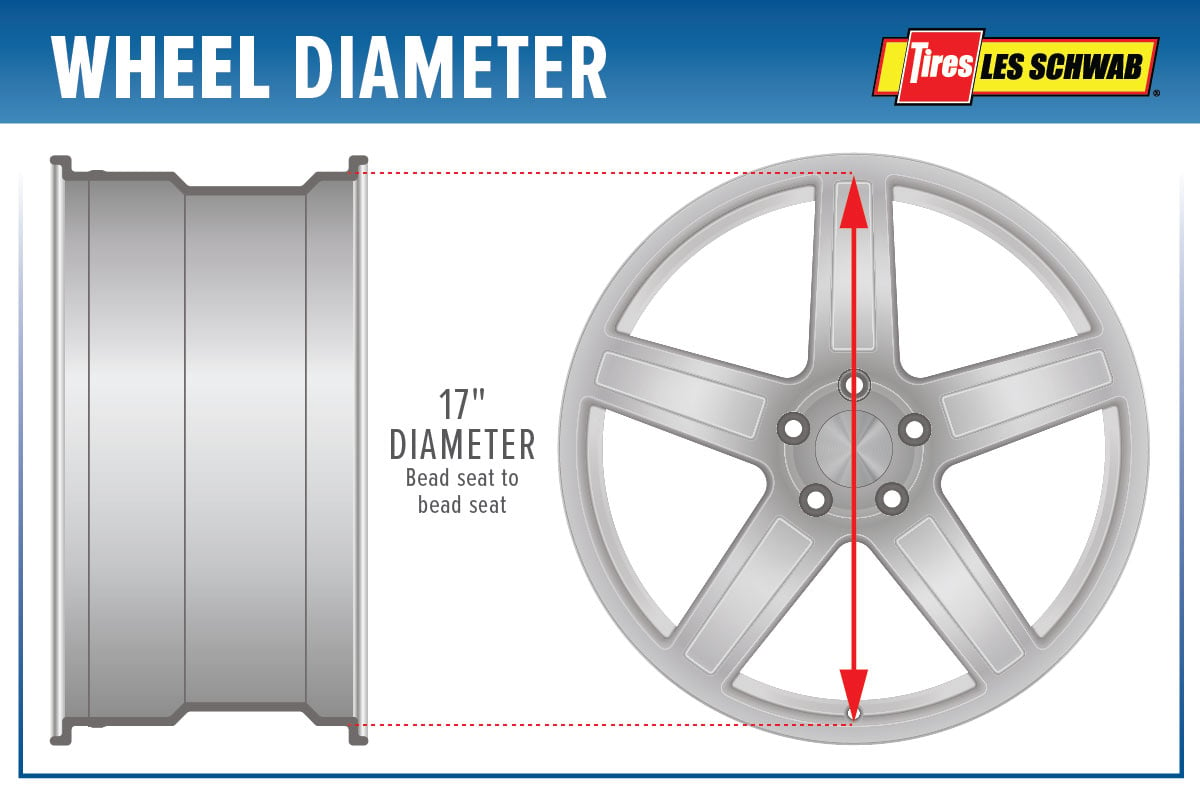
Overall Diameter: The wheel and tire combination should always clear the braking components, suspension parts, and the body of the vehicle. This is important whether you want to increase the diameter of your wheels for a street-worthy look, or decrease the wheel diameter for more tire sidewall and better off-road performance.
Offset and Backspace: To ensure proper clearance, it’s critical to know how far inside and outside the entire wheel and tire package will sit in the wheel well. Improper backspace or offset can cause interference with things like the body and steering components, and possibly decrease your turning radius.
Proper Mounting: Many of today’s vehicles come from the factory with wheels that fit precisely around the hub. This is referred to as hub-centric fitment, which helps provide a consistent centering of the wheel and tire assembly when mounted to the vehicle. This reduces the chance of an imbalance that may result in a vibration in the steering wheel or seat while driving. Our team understands the importance of maintaining a hub-centric fit whenever aftermarket wheels are being considered.
How to Pick the Right Size
There are many sizes to consider when purchasing new wheels. The image below is an example of how plus and minus sizing works. Plus sizing boosts the diameter of your wheels while decreasing the profile of the tire sidewall to match the overall tire diameter suggested by the manufacturer. Minus sizing works in the opposite way to allow for a taller sidewall.

Here’s a comparison of how two wheel-tire packages of different sizes look on the same vehicle.
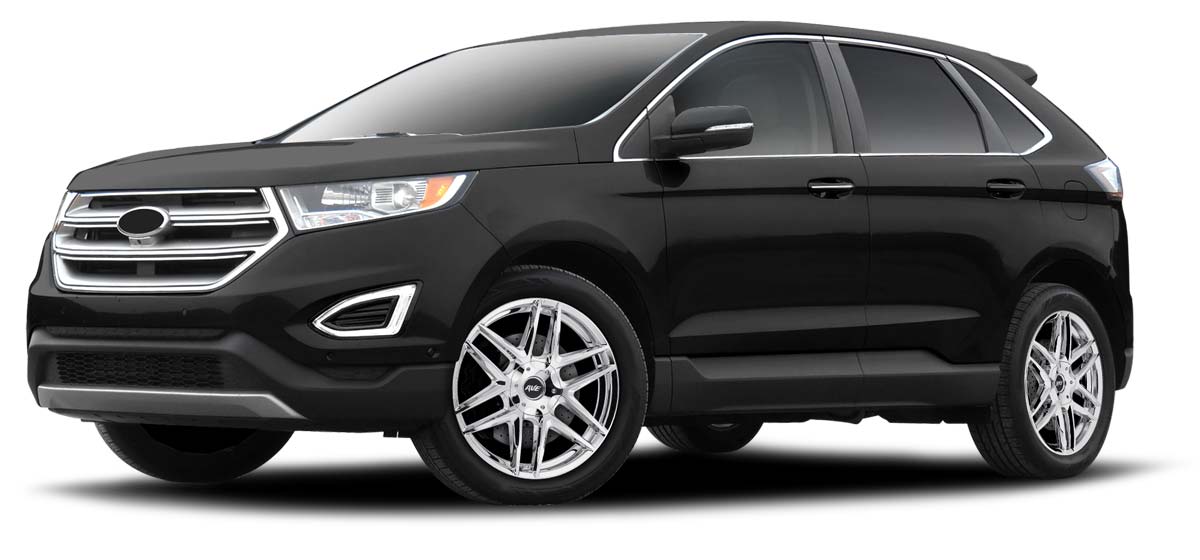
Car with 18-inch wheels. Note the higher tire sidewall. 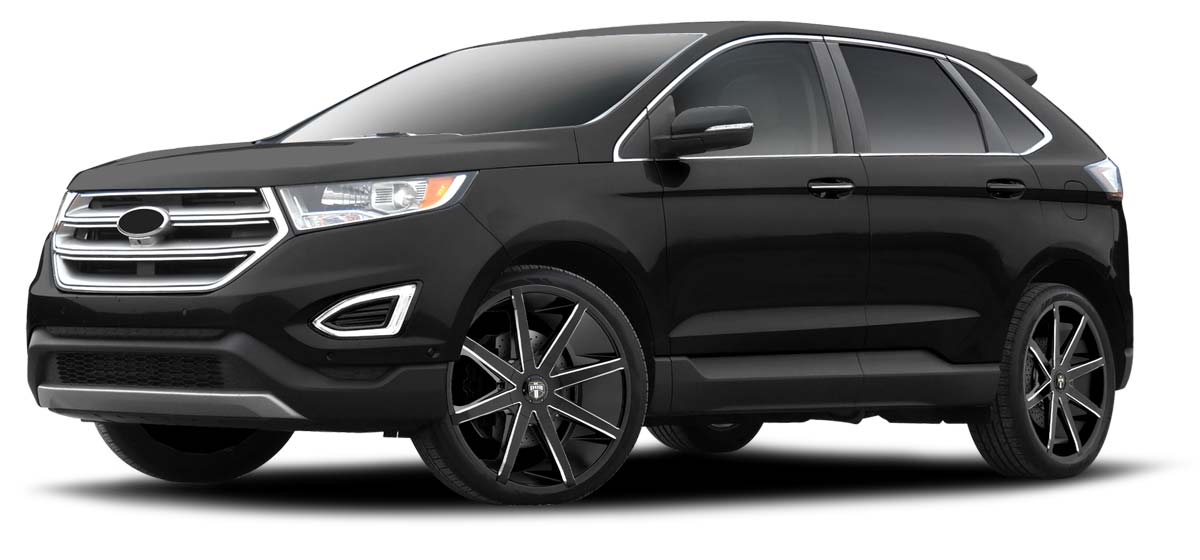
Car with 20-inch, plus-sized wheel and low-profile tire. Note the shorter tire sidewall.
Bolt-Pattern Matters
There are a variety of bolt patterns and your new custom wheels must match in order to fit your vehicle properly. Even if your vehicle has five lugs, there’s no guarantee that every five-hole wheel will fit. At Les Schwab, we stock thousands of custom wheels and can help you find the right bolt pattern and fit for your vehicle.
Check the Tech
TPMS (Tire Pressure Monitoring System) compatibility is also important. Equipped in most new vehicles, the TPMS in your vehicle should be reset after installing new wheels. At Les Schwab, we take care of that for you.
Les Schwab Knows Custom Wheels
Keep in mind, that your options will be specific to the make and model of what you drive. Our team of pros understands what wheel and tire sizes will fit your vehicle and meet your performance expectations. Stop by today and to check out your options. With every custom wheel sale, Les Schwab will give you a free, written warranty good at any of our locations. This gives you peace of mind as you roll away on your new custom wheels.
Opens warranty information dialog with language options
